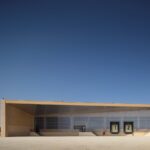Introduction
In 2022, ARC Arquitectos completed the Nogam Walnut Factory, situated in the Municipality of Évora, Portugal. Spanning approximately 11,000 square meters, the factory was meticulously designed to meet legal, programmatic, and geographic requirements while seamlessly integrating into its surroundings.

Triangular Layout and Central Courtyard
The factory’s design revolves around a triangular reference shape mandated by legal conditions. Embracing this form, the architects arranged the program around a central courtyard, fostering an efficient and harmonious layout.

Optimized Program Distribution
The program, structured as a continuous workflow, was tailored to suit the factory’s circular layout. Priority was given to positioning the walnut drying zone to leverage prevailing winds. Patios and perforated walls were strategically incorporated to facilitate airflow, enhancing the drying process. The program flows logically from reception through drying to storage and dispatch areas, ensuring operational efficiency.

Sun Exposure and Natural Ventilation
The triangular layout, coupled with the central courtyard, maximizes sun exposure and natural ventilation while minimizing the need for external access points. The building’s volumetry was carefully crafted to blend with the landscape, featuring varied facade heights and a sloped roofline to reduce visual impact.

Landscape Integration and Materiality
Materials were selected to harmonize with the landscape, with a clayey appearance chosen to blend seamlessly with the surroundings. Perforated walls, inspired by traditional Alentejo and Algarve architecture, provide both visual interest and functional airflow. The use of prefabricated structures and pigmented concrete panels with thermal insulation ensures durability and energy efficiency.

Conclusion
The Nogam Walnut Factory stands as a testament to ARC Arquitectos’ commitment to integrating architecture with functionality and landscape. By adhering to legal requirements while prioritizing efficient program distribution, optimizing natural elements, and selecting appropriate materials, the factory not only meets its operational needs but also enhances the visual and environmental quality of the surrounding area.
















